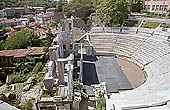One of the oldest European towns contemporary to Тroya and Mikena, Plovdiv
currently is a modern city with an ancient charm emanating from its numerous remains.
Encircled by the Maritsa River, one of the ancient crossroads between East and West
in the Thracian Plain, Plovdiv has a 24 centuries long history. The Thracians named it Eumolpia. Then in 342 BC, when Philip II of Macedonia seized the city, it was renamed to Philippopolis, and finally the Romans called it
Trimontium. Under the name of Puldin, the city was included in the First Bulgarian Kingdom
(ix century). During the Ottoman domination known as Filibe the city gradually declined.
But during the Revival Period Plovdiv regained economic strength and was the most populated town in the Bulgaria with a variety of ethnic groups: Bulgarians, Turks, Greeks, Armenians, and Jews. The city
importance is due to the Architectural complex of the old town, with its integrity and preservation with a homogeneous structure, where along narrow cobble-paved streets there are residential and public houses from the National Revival Period. The Archaeological Complex
'Nebet Hill' remains within the Northern part of the Trimontium area.
Plovdiv architectural complex |

|
Old Town of Plovdiv Architecture Reserve
Built over Trimontium (Three Hills), the original location of the town, the Plovdiv historic centre had preserved remains of the
fortress wall which encircled it and the Hissar Kapia gate (Hjsçar Kapja).
The lovely houses are built in the so called Plovdiv style: a unique variety
of the National Revival vernacular architecture. During the xix century,
at the end of the Ottoman domination, over the medieval irregular street network,
rich merchants built their houses with large bay windows, latticed eaves and heavy oak gates, green yards and fountains.
Walls are frequently decorated with characteristic alafranga, niches usually decorated with a landscape or with floral motifs. Many of the houses are now
museums and can be visited.
Argir Koyumdjiouglu House (1847) the Ethnographic Museum is a fine example of the Bulgarian Baroque architecture. The main facade gives onto a garden and consists of two differentiated bodies with the middle part projecting far forwards.
Hindilian's House (1835). The attics are decorated in oriental style, with landscape wall-paintings. It hosts the Exposition of the Revival Period Urban Life-style
Georgi Mavridi House, also known as Lamartin's House because the French poet lived here in 1833. The house typically expands outwards with each storey by means of timber-framed oriels to satisfy the demands for spacious interiors.
Dimitar Georgiadi House (1846) this ochre house with symmetrical design today host the Museum of the National Liberation of the Bulgarian Revival.
House of Dr Chomakov, now the Art Gallery.
The Balabanovs House, now Museum of the Revival Style.
Nikola Nedkovich House (1863) currently Museum of the Urban Revival
Style, classic example of symmetrical house, with richly decorated Green room and Red
room.
Interesting churches are:
the Cathedral 'The Holy Mother of God' Church (1844).
St Konstantine and Elena Church (1832) built on the wall of the acropolis. Inside icons painted by Zachary Zograph, some date back to the xiv c.
Church St. Marina (1856) with a very interesting wood-carved iconostasis.

|
Plovdiv architectural complex
|
The Ancient Theatre
The Roman Amphitheatre, built by Emperor Mark Aurelius in 2nd c. AC, is one of the biggest and best preserved of the Balkan Peninsula outside Greece. Situated close to the southern entrance of the former Roman fortress, the amphitheatre is divided into two rings of 14 rows each. Most probably the theatre had a capacity of 7000 spectators. The two-level stage presents decorative details.
Plovdiv architectural complex |

|
Djumaya Mosque
Djumaya Mosque (from Turkish Friday), known also as Ulu Mosque, in the centre of Plovdiv is one of the biggest and the oldest mosques in Bulgaria. It is an extremely solid building with thick stone walls covered by
domes and with a 23 m high minaret decorated with zigzag lines. It is one of the oldest Ottoman buildings still preserved on the entire Balkan Peninsula.

|
Plovdiv
|
|
|
|



